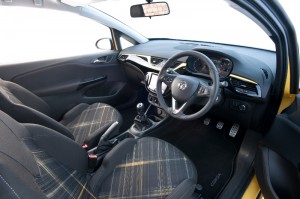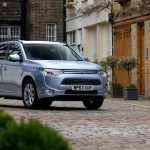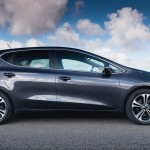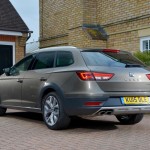I’m looking at a couple of new cars. The ‘old’ and the ‘new’ of the title refer to the power source, for one is powered by the old fossil fuel, the other by electricity, and such is the vast amount of interest generated by the electric one, I’ll start there.
The Tesla Model S is one of the large number of electrically powered cars to be launched in the last few years. Unlike most of them this one is powered solely by electricity, with no petrol or diesel engine to assist the power or range of the vehicle.
Previous electric-only cars have illustrated that although electric motors can generate enough power to give a car reasonable performance, a range of around 100 miles is about all we can hope for.
So if I tell you that the Model S has a range of some 250 miles between charges, and acceleration to rival the very fastest BMW, you might be surprised. However, that’s what Tesla has provided.
 I tested the car on Sussex roads that had all the benefits of an English early autumn – damp, leafy, potholed surfaces that test a car’s suspension to the ultimate degree. The car looks stylish in an understated way – rather Maserati at the front, though less impressive at the rear.
I tested the car on Sussex roads that had all the benefits of an English early autumn – damp, leafy, potholed surfaces that test a car’s suspension to the ultimate degree. The car looks stylish in an understated way – rather Maserati at the front, though less impressive at the rear.
The interior is smart, and again rather understated save for the screen. When I say ‘screen’ you’ll be thinking of the wee things that carry sat nav info. This one is by comparison a giant, roughly A4 portrait sized, and on it you control just about everything. There are a couple of stalks on the steering column, but almost every element from sat nav to seat position memory is dealt with on-screen.
Length of the Model S is a prodigious 16’4”, so it’s no surprise that leg room in both front and rear seats is generous. What might impress you more though is the luggage space, for since the electric motors are located at the rear axle (the car is rear-wheel drive), there’s no engine under the bonnet, so luggage can go here and in the boot, which itself is very large.
End result is luggage volume of 895 litres (32 cubic feet) even before folding down the rear seat backs. There’s an option to add two rear-facing seats at the rear instead of enjoying all that luggage space.
To say that this is an automatic is not quite true, as the motor will happily accelerate from zero revs right up to its maximum of 16,000rpm, so there’s no need for a gearbox of any kind. Unlike normal car engines the electric motor generates full torque (accelerative push) immediately, so there’s no delay at all on pressing the throttle.
It really is a remarkable experience, and one which an owner would enjoy as long as they owned the car. Should too much throttle be used on a greasy corner, the traction control and stability program sort it out quickly and noticeably. That needed testing, so I did! Ride is softish, but the big tyres hang onto the tarmac well enough; bad surfaces can however induce some hopping.
 The performance of the ‘S’ is huge, despite its kerb weight of over two tons. With a plethora of aluminium in its make-up, why is it so heavy? Well, it’s a big car, and underneath the passenger compartment is a ginormous battery pack weighing in at over half a ton. And thereby hangs a major difficulty, for the plus of the 250-mile range is balanced by a minus when it comes to recharging. Even with the appropriate ‘Type 2’ wall box you’ll be waiting around 12 hours for a full charge at home.
The performance of the ‘S’ is huge, despite its kerb weight of over two tons. With a plethora of aluminium in its make-up, why is it so heavy? Well, it’s a big car, and underneath the passenger compartment is a ginormous battery pack weighing in at over half a ton. And thereby hangs a major difficulty, for the plus of the 250-mile range is balanced by a minus when it comes to recharging. Even with the appropriate ‘Type 2’ wall box you’ll be waiting around 12 hours for a full charge at home.
 Go to a fast charging station, of which there are a growing number, and the process should be somewhat quicker, but you perhaps won’t be that popular with drivers behind you in the queue. Best of all is the Supercharger option, which is Tesla’s own network of high power recharging points geared to Tesla cars only.
Go to a fast charging station, of which there are a growing number, and the process should be somewhat quicker, but you perhaps won’t be that popular with drivers behind you in the queue. Best of all is the Supercharger option, which is Tesla’s own network of high power recharging points geared to Tesla cars only.
Half an hour here is enough for 170 miles of charge, and it’s free! These stations are strategically placed, but there won’t of course be too many of them. I drove the 85kWh version of the Tesla, but there is also a less expensive 65kWh version, which would require less charge time.
In one giant leap for mankind the Model S has brought us to the next generation of electric transport. Coming soon is a smaller, cheaper car that should widen the appeal, while the Model S is now adding 4WD capability to the range, with the option of even more power.
With a few more fast charging stations and a fair sprinkling of Tesla’s own Superchargers, practical worry-free electric motoring is getting closer. Here in the UK, where most of our electricity is fossil-derived, it’s not of course a particularly green way of motoring, but as wind and solar power increase, the eco-nature of the cars becomes clearer. The French after all, with their predominantly nuclear network, are already that way.
Tesla Model S
Size: 4970 x 2187mm inc mirrors
Range: 215 – 285 miles depending on model
Price: from £52,080
Further info: www.teslamotors.com/en_GB
Back to more everyday transport, and I’m sure Vauxhall won’t mind me styling their new Corsa in that fashion, because everyday motoring is what it’s designed for.
 The Corsa has been Vauxhall’s best-selling car for many years, vying with Fiesta for the UK’s Number One spot and topping sales charts in Scotland and Northern Ireland outright. In its last full year, 84,000 were sold, outstripping total sales of manufacturers like SEAT, Skoda, Renault and Citroen.
The Corsa has been Vauxhall’s best-selling car for many years, vying with Fiesta for the UK’s Number One spot and topping sales charts in Scotland and Northern Ireland outright. In its last full year, 84,000 were sold, outstripping total sales of manufacturers like SEAT, Skoda, Renault and Citroen.
Such is its popularity, the UK is now the lead market for Corsa by a large margin (Germany was the second biggest market in 2013 with around 50,000 sales). Taking Europe as a whole, Corsa is the second most popular nameplate across the continent after 32 years in the market. with a total 12 million sold.
The new model, available from December, is recognisably descended form the previous one, but a bit sharper thanks to new lights and front grille, and the two clear creases which now adorn the doors.
 Available with 3 or 5 doors, the two models are noticeably different; the main change being at the rear where the 3-door has triangular windows about half the size of those of the 5-door. That naturally results in a less impressive view for the 3-door driver, but many buyers will put up with that for the looks of the thing.
Available with 3 or 5 doors, the two models are noticeably different; the main change being at the rear where the 3-door has triangular windows about half the size of those of the 5-door. That naturally results in a less impressive view for the 3-door driver, but many buyers will put up with that for the looks of the thing.
The big news under the bonnet is the new 3-cylinder engine, which packs a punch and is not merely the most frugal choice. Amazingly, this 1-litre engine is actually the most powerful in the range (though there’s also a less powerful 90PS version).
 I drove both it and the 1.4 petrol, and having done so I’d say the only reason you’d go for the 1.4 is that it’s cheaper; the 1-litre has better performance and fuel economy, and a more sporty exhaust note if you’re keen on that sort of thing.
I drove both it and the 1.4 petrol, and having done so I’d say the only reason you’d go for the 1.4 is that it’s cheaper; the 1-litre has better performance and fuel economy, and a more sporty exhaust note if you’re keen on that sort of thing.
What constantly surprised me about the 1-litre is its acceleration from low revs; it picks up with as much gusto as would a diesel, so leaving the car in a high gear (there are six) won’t leave you short of oomph.
On the subject of fuel economy I should say that the range-topping 1-litre engine is just a couple of mpg better than the 1.4, but would be likely to suffer a greater hit if used hard than would the 1.4.
Vauxhall have cleverly offered buyers a host of choices when it comes to specification: nine trim levels should ensure that one of them has the car pretty much as you want it. All of them have a heated windscreen as standard, and if you ever drive with one of these on a winter’s morn, believe me you’ll never again want to be without it!
 Space in the car is surprisingly generous; a six-footer can sit behind another one with ample room for their head and legs. Boot space is 10 cubic feet (285 litres), rising to 39 when the rear seat backs are folded down; that’s not bad, and certainly more than I expected bearing in mind the passenger space.
Space in the car is surprisingly generous; a six-footer can sit behind another one with ample room for their head and legs. Boot space is 10 cubic feet (285 litres), rising to 39 when the rear seat backs are folded down; that’s not bad, and certainly more than I expected bearing in mind the passenger space.
Cabin design is brighter and, depending on your choice of trim, more colourful than the average; Vauxhall have tried to offer more than the ubiquitous black, and the result to my eyes looks good. More to the point in the long term is that the materials used are of solid quality.
Ride quality is another plus for the new car; even models that have ‘sports suspension’ don’t feel too firm. Standard suspension is very compliant, yet roadholding is extremely capable.
If I go on to say that prices are noticeably down from the previous model – and significantly less than those of its arch-rival, the Fiesta – you could infer that I was impressed with the new Corsa. You wouldn’t be wrong.
by Peter Cracknell
Vauxhall Corsa
Size: 4.02m x 1.94m inc mirrors
Price: from £8,995
Further info: www.vauxhall.co.uk




